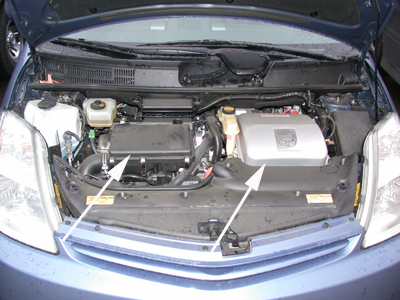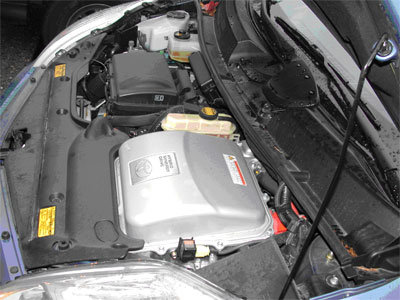|
|
Hybrid Vehicles
Hybrid vehicles are characterized by having more than one drive system. Typically, gasoline engines and electric motors are employed to use the most effective operation of each. The gasoline engine is relatively efficient when operated at a steady speed for which it was optimally geared. Thus, at a constant highway speed gasoline engines provide good gas mileage. Electric motors are more efficient at lower and changing speeds and are therefore optimal for stop-and-go city driving. Hybrids are designed to automatically determine which drive system to utilize and to what degree for a given driving condition.
Hybrids are inherently more complicated and expensive due to having multiple drive systems, the necessary gearing to connect them to the drive wheels and processing to determine how each motor is used.
 Photograph under the hood of a 2005 Toyota Prius. The arrow to the left indicates the top of the internal combustion engine. The arrow to the right indicates the top of the inverter/converter; the electric motor and transaxle are below. Fluid reservoirs are also evident. |
 Photograph of the same Toyota Prius looking in from the driver’s side. |
Hybrid vehicles may connect drive motors in series, parallel, or a combination of both systems. The Toyota Prius includes two electric drive motors as well, one on each axle. Power assisted steering is frequently applied electrically (as in the 2005 Toyota Prius and Honda hybrids), eliminating the need for hydraulic fluid. Gasoline, coolant, engine oil, brake, automatic transmission and windshield wiper fluids are generally present as liquid fuels.
In addition to traditional sources of fuel and ignition, hybrid vehicles also have high voltage wiring and battery supplies. A 12-volt lead-acid battery is often mounted in an easy-to-find location, with either a Nickel Metal Hydride (NiMH) or lead-acid high-voltage battery pack hidden beneath panels in the trunk or passenger compartment. The battery packs have individual cells wired in series to develop high voltage, which is carried in large orange cables from the battery compartment to the inverter/converter under the hood. The inverter/converter takes the DC voltage from the batteries, converts it to the voltages needed for various vehicle systems, and inverts it to AC for the electric drive motors. AC motors are used for their greater efficiency
The Chevrolet manufactures a version of the Silverado that is an example of another variation of called a “mild hybrid” vehicle. The gasoline engine of the Silverado shuts off when braking and at idle. A 42-volt electric motor is used to generate electrical energy during braking and for smooth starts when the brake pedal is released in order to begin acceleration. Three lead-acid batteries provide the voltage for the electric motor. The fuel savings is generated through the regenerative braking and engine shut-down when power is not needed.
For more information about voltage used in some hybrids, click here.
|
|
|